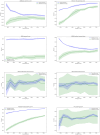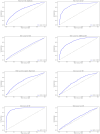Unlocking the potential of wearable technology: Fitbit-derived measures for predicting ADHD in adolescents
- PMID: 40487008
- PMCID: PMC12142065
- DOI: 10.3389/frcha.2025.1504323
Unlocking the potential of wearable technology: Fitbit-derived measures for predicting ADHD in adolescents
Abstract
Background: Attention-deficit/hyperactivity disorder (ADHD) is a common neurodevelopmental disorder with a complex etiology. The current diagnostic process for ADHD is often time-intensive and subjective. Recent advancements in machine learning offer new opportunities to improve ADHD diagnosis using diverse data sources. This study explores the potential of Fitbit-derived physical activity data to enhance ADHD diagnosis.
Method: We analyzed a sample of 450 participants from the Adolescent Brain Cognitive Development (ABCD) study (data release 5.0). Correlation analyses were conducted to examine associations between ADHD diagnosis and Fitbit-derived measurements, including sedentary time, resting heart rate, and energy expenditure. We then used multivariable logistic regression models to evaluate the predictive power of these measurements for ADHD diagnosis. Additionally, machine learning classifiers were trained to automatically classify individuals into ADHD+ and ADHD- groups.
Results: Our correlation analyses revealed statistically significant associations between ADHD diagnosis and Fitbit-derived physical activity data. The multivariable logistic regression models identified specific Fitbit measurements that significantly predicted ADHD diagnosis. Among the machine learning classifiers, the Random Forest outperformed others with cross-validation accuracy of 0.89, AUC of 0.95, precision of 0.88, recall of 0.90, F1-score of 0.89, and test accuracy of 0.88.
Conclusion: Fitbit-derived measurements show promise for predicting ADHD diagnosis, with machine learning classifiers, particularly Random Forest, demonstrating high predictive accuracy. These findings suggest that wearable data may contribute to more objective and efficient methods for ADHD identification, potentially enhancing clinical practices for diagnosis and management.
Keywords: ADHD; adolescent mental health; fitbit-derived physical activity; machine learning; wearable technology.
© 2025 Rahman.
Conflict of interest statement
The author declares that the research was conducted in the absence of any commercial or financial relationships that could be construed as a potential conflict of interest.
Figures






Similar articles
-
Machine learning-enabled detection of attention-deficit/hyperactivity disorder with multimodal physiological data: a case-control study.BMC Psychiatry. 2024 Aug 5;24(1):547. doi: 10.1186/s12888-024-05987-7. BMC Psychiatry. 2024. PMID: 39103819 Free PMC article.
-
The utility of wearable electroencephalography combined with behavioral measures to establish a practical multi-domain model for facilitating the diagnosis of young children with attention-deficit/hyperactivity disorder.J Neurodev Disord. 2024 Nov 11;16(1):62. doi: 10.1186/s11689-024-09578-1. J Neurodev Disord. 2024. PMID: 39528958 Free PMC article.
-
Unlocking the Potential of Wear Time of a Wearable Device to Enhance Postpartum Depression Screening and Detection: Cross-Sectional Study.JMIR Form Res. 2025 May 23;9:e67585. doi: 10.2196/67585. JMIR Form Res. 2025. PMID: 40409746 Free PMC article.
-
Automated ADHD detection using dual-modal sensory data and machine learning.Med Eng Phys. 2025 May;139:104328. doi: 10.1016/j.medengphy.2025.104328. Epub 2025 Mar 24. Med Eng Phys. 2025. PMID: 40306880
-
Machine Learning Techniques for the Diagnosis of Attention-Deficit/Hyperactivity Disorder from Magnetic Resonance Imaging: A Concise Review.Neurol India. 2021 Nov-Dec;69(6):1518-1523. doi: 10.4103/0028-3886.333520. Neurol India. 2021. PMID: 34979636 Review.
References
-
- Varrasi S, Boccaccio FM, Guerrera CS, Platania GA, Pirrone C, Castellano S. Schooling and occupational outcomes in adults with ADHD: predictors of success and support strategies for effective learning. Educ Sci (Basel). (2022) 13(1):37. 10.3390/educsci13010037 - DOI
LinkOut - more resources
Full Text Sources

